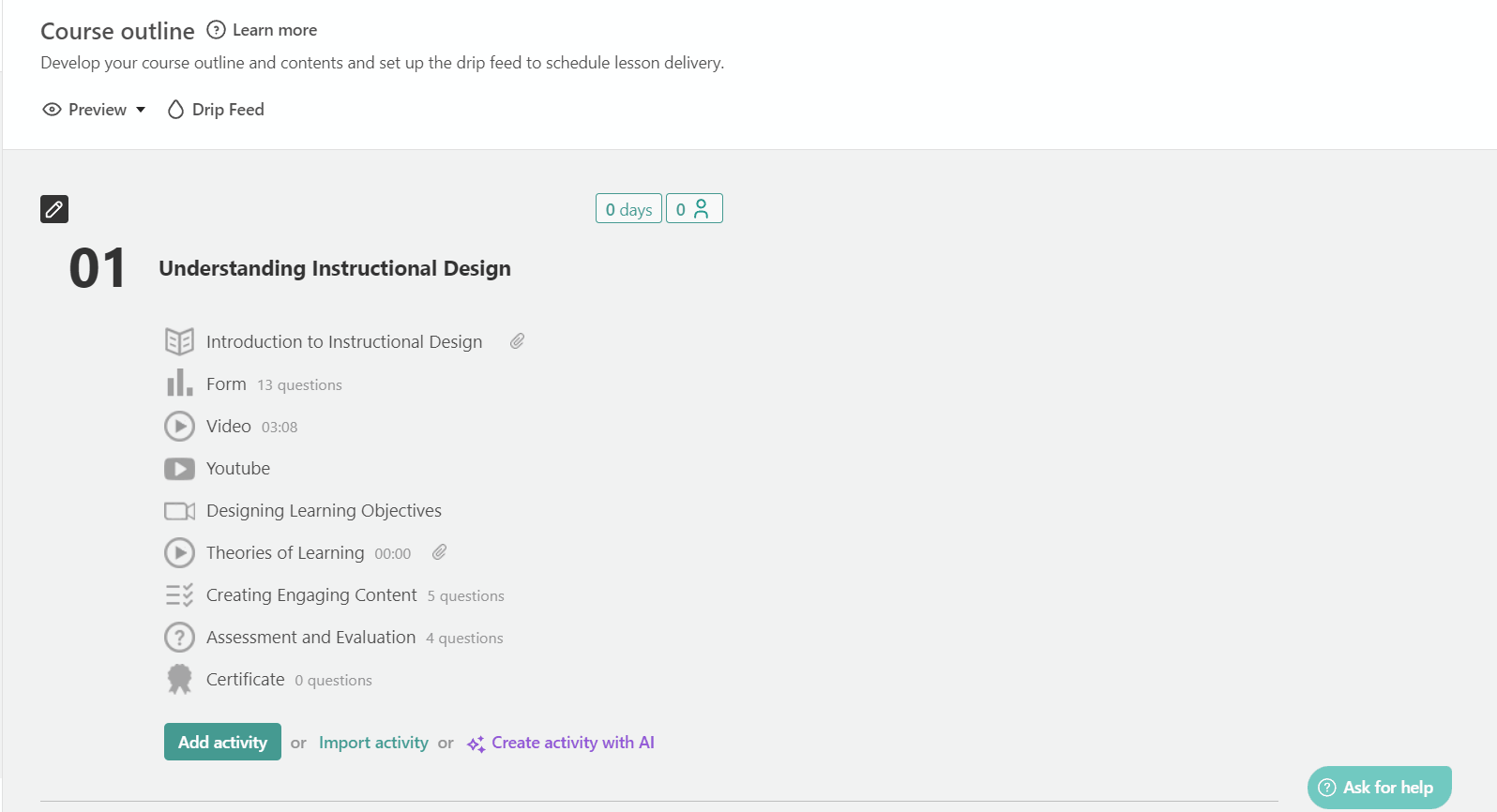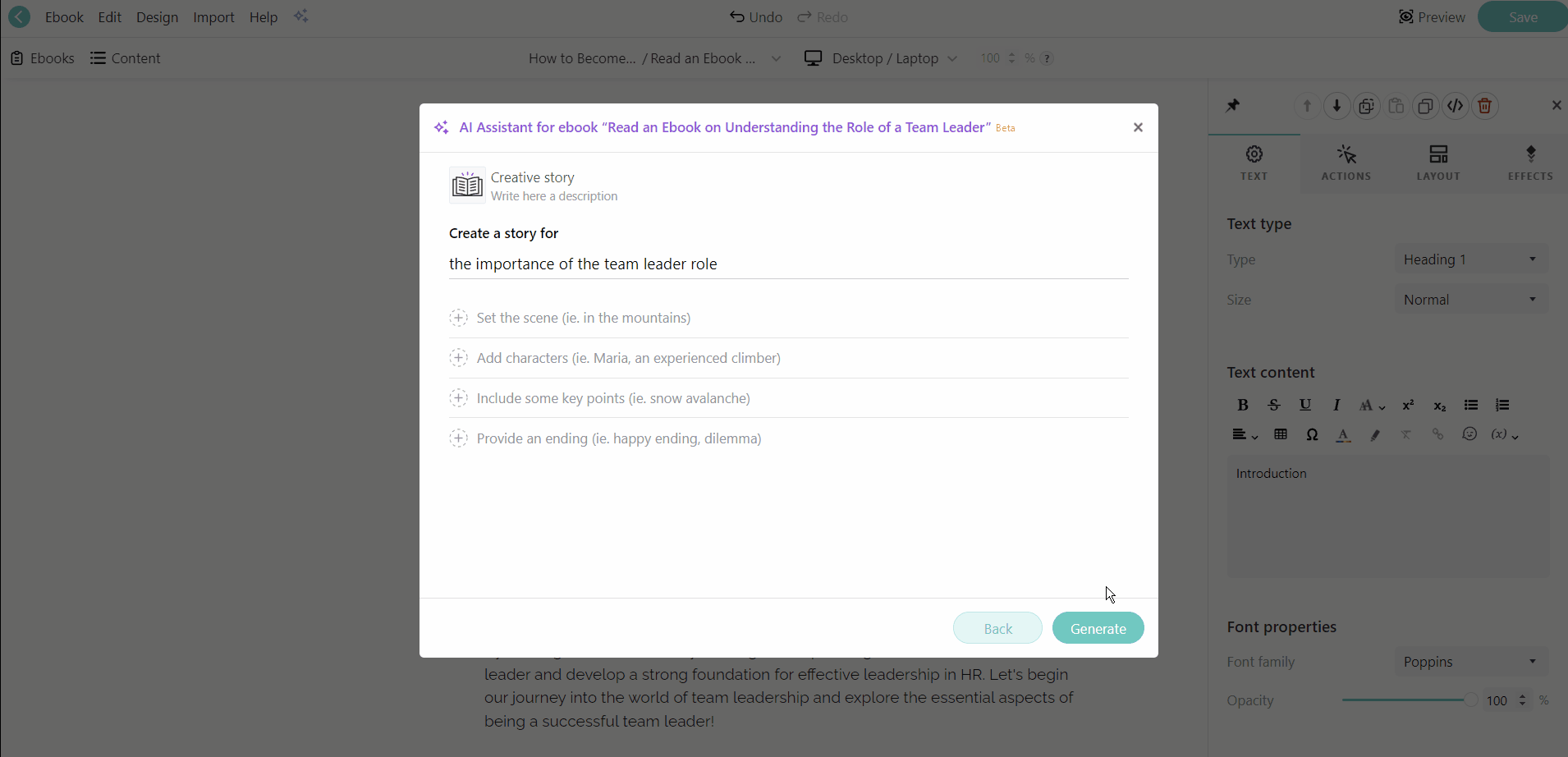Crafting Creative Learning Experiences with AI: Key Strategies & Prompts
I stared at my computer screen, utterly deflated. The online course I’d poured my heart and soul into for months was barely getting any traction. Sound familiar?
As a fellow course creator, I’ve been exactly where you are. That sinking feeling when your meticulously crafted content fails to engage learners or worse, sees them dropping off midway – it’s enough to make you question everything.
But here’s the thing: your expertise is not the problem. It’s not even the value of your content. The missing ingredient? Creative Learning. I discovered this the hard way, and it transformed not just my courses, but my entire approach to learning design.
Discover LearnWorlds AI-Powered Tools
Whether you’re an independent course seller trying to stand out in a crowded market or an L&D professional grappling with low engagement rates, creativity might just be the game-changer you’ve been looking for.
Why Creativity Matters in Modern Learning Design
Remember that Gallup report from 2019? It wasn’t just talking about traditional classrooms. The findings are just as relevant for us in the online learning space. When we prioritize creativity and use technology in innovative ways, we see remarkable results, such as:
Increased engagement: No more glazed-over eyes or silent discussion boards. Creative approaches spark curiosity and keep learners coming back for more.
Improved critical thinking: By presenting information in novel ways, we challenge learners to make new connections and think outside the box.
Better retention: When learning feels like an adventure rather than a chore, the information sticks.
But here’s the real kicker – creative learning isn’t just about making things “fun.” It’s about tapping into how the brain prefers to learn. That is:
Through exploration: Ever noticed how a child learns naturally through play? That instinct doesn’t disappear in adulthood.
By sparking curiosity: When we’re genuinely intrigued, we’re more likely to dive deep into a subject.
With practical application: Abstract concepts come alive when we can see how they work in the real world.
Think about the last time you were truly excited to learn something new. What made that experience different? How can you recreate that feeling in your own course creation?
Thinking Outside the Box: Using AI for Creative Learning Experiences
Now, I know what you’re thinking. “Creativity sounds great, but I’m not exactly the next Picasso.” Trust me, I felt the same way. That’s where AI in learning design comes in as your secret weapon. It’s not about replacing your expertise but rather amplifying your creative potential.
AI can act as a powerful ally in this process. We are not only talking about automating tasks or generating text; AI can help you explore uncharted creative territory, offering unique insights and suggestions that push beyond conventional learning design techniques.
Let’s dive into how AI can inspire out-of-the-box thinking and transform your courses into a dynamic, memorable experience.
Enter Artificial Intelligence (AI): Your New Creative Ally
AI is a powerful partner that can help you think outside the box and explore new creative avenues. Imagine having a brainstorming assistant who never runs out of innovative suggestions, helping you push beyond conventional course design.
How Does AI Generate Creative Content?
It’s not magic—it’s sophisticated technology at work. AI models are trained on vast amounts of data, learning to recognize patterns and generate human-like responses.
When you prompt it with a specific topic or challenge, it analyzes patterns and context to produce content that is not only coherent but often surprising and thought-provoking. This is a form of adaptive learning, where AI assesses individual data to tailor personalized content, enhancing the learning experience.
For example, if you ask ChatGPT or Claude for creative ways to teach market segmentation, it might suggest an interactive role-playing game where learners create personalized customer profiles using data-driven personas.
The Importance of Personalized Learning
Personalized learning is another key cornerstone of effective teaching. This approach tailors the learning experience to meet the unique needs, abilities, and learning styles of each individual student.
Recognizing that every student learns differently and at their own pace, personalized learning seeks to provide a customized educational journey that caters to these differences.
Imagine a classroom where each student is not just another face in the crowd but an individual with distinct learning preferences and prior knowledge. Personalized learning transforms this vision into reality by creating an environment where students can thrive.
💡 Check out this webinar to learn how to create personalized learning experiences.
Whether a student excels in visual learning or prefers hands-on activities, personalized education ensures that their unique needs are met, fostering a more engaging and effective learning process.
Essential Strategies for Crafting Engaging Learning Experiences
Incorporating creativity into your learning experiences means you’ll be adding more interactive elements to your learning activities, but also transforming the way learners engage, think, and apply knowledge. Educational institutions are integrating AI into their teaching methods to enhance personalized learning experiences for students, bridging resource and equity gaps, and fostering a more inclusive and effective classroom environment.
To help you get started, here are four key strategies that can enhance your course creation. These techniques will transform your courses from “meh” to “wow”:
Creative Thinking Techniques
Role-Playing Techniques
Critical Thinking Techniques
Humor Expression Techniques
In the following sections, we’ll explore each technique in more detail, offering prompt examples, which you can modify according to your needs to help you unlock the full potential of AI in your creative learning design.
1. Creative thinking techniques
Creative thinking techniques can help you break free from traditional thought patterns and develop innovative solutions for your learning experiences.
Let’s dive into three powerful strategies: Analogies, Role or Person Imitation, and De Bono’s Six Thinking Hats. Each of these techniques brings a unique approach to explaining complex concepts in a more relatable and engaging manner.
I. Analogies
Analogies are a fantastic way to simplify complex ideas by relating them to familiar concepts. They create a bridge between new information and what learners already know, making it easier to grasp difficult topics. In educational settings, analogies can be particularly effective because they foster an intuitive grasp of difficult subjects.
For instance, the concept of network security can be made more comprehensible by comparing it to a medieval castle with walls, gates, and guards. Each element of network security—firewalls, passwords, encryption—can be likened to physical defenses, making the abstract idea of cybersecurity more concrete and easier to conceptualize.
Prompt Example:
“Act as a marketing and business consultant designing a course on marketing and business strategies for beginner learners. Use an analogy from cooking to explain the concept of market segmentation.”
Prompt Example:
“Act as a financial advisor designing a course on personal finance for young adults. Use an analogy from gardening to explain the concept of compound interest. This analogy should be used during the main content section of the course to reinforce understanding of long-term financial growth. The analogy should be suitable for an online video format and should take approximately 4 minutes to present.”
II. Role or Person Imitation
Role or person imitation can add an element of fun and engagement to your lessons. By imitating a well-known character (e.g., Sherlock Holmes, Indiana Jones, Anakin Skywalker, etc.) or personality (e.g., Ophrah, Elon Musk, Obama, etc), you can present information in a memorable way that resonates with your audience.
In education, this technique allows teachers to infuse creativity and storytelling into their lessons. For instance, adopting the persona of Sherlock Holmes while teaching critical thinking skills can turn a routine exercise into an engaging detective mystery, encouraging students to analyze information more deeply.
This way you can transform traditional lectures into dynamic, interactive experiences that promote active learning and foster a deeper connection to the subject matter.
Prompt Example:
“Act as an instructor designing a course on conflict resolution for beginners. Explain the concept of active listening in the style of the pirate Jack Sparrow.”
Prompt Example:
“Act as a literature professor designing a course on creative writing for high school students. Explain the concept of character development in the style of Willy Wonka. This explanation should be used during the review section of the course to summarize key principles in a memorable way. The explanation should be suitable for an audio format and should take approximately 6 minutes to present. ”
III. De Bono’s Six Thinking Hats
De Bono’s Six Thinking Hats is a structured technique that encourages looking at a problem from multiple perspectives. Each hat represents a different type of thinking—information, emotions, caution, benefits, creativity, and process—providing a comprehensive view of any issue.
By assigning each student or group a different ‘hat,’ teachers can guide discussions where learners systematically explore all aspects of a topic. This structured approach helps students develop a balanced perspective and encourages them to empathize with different viewpoints, fostering a more inclusive and thorough analysis.
Whether applied to debates, project planning, or decision-making exercises, De Bono’s Six Thinking Hats makes learning more interactive and thought-provoking, ultimately enhancing students’ analytical skills and creativity.
Prompt Example:
“Act as a learning designer and use De Bono’s Six Thinking Hats strategy to explain the various arguments about the importance of gender-inclusive behavior among colleagues in the business sector.”
Prompt Example:
“Act as a learning designer and use De Bono’s Six Thinking Hats strategy to create a set of flashcards that on the one side share an explanation of the hat and on the other side offer the relevant arguments explaining the ethical implications of artificial intelligence in healthcare for mid-level managers in a technology company during a face-to-face webinar. The cards will facilitate the virtual debate of the mid-level managers.”
2. Role-Playing Techniques
Role-playing techniques are powerful tools for creating immersive and interactive learning experiences. By placing learners in realistic scenarios and assigning them specific roles, you encourage active participation, empathy, and problem-solving skills.
These techniques go beyond traditional learning methods by allowing participants to experience different perspectives, practice real-world skills, and gain deeper insights into complex situations.
I. Simulation Role-Playing
Simulation role-playing places learners in lifelike situations, enabling them to practice and refine their skills in a safe and controlled environment. This approach allows learners to practice delivering difficult messages with empathy and professionalism.
For example, students could take on the roles of historical figures to debate key decisions or act as business professionals navigating a challenging negotiation. This hands-on approach deepens understanding and cultivates essential skills such as communication, critical thinking, and collaboration.
When stepping into someone else’s shoes, learners can explore diverse viewpoints, develop empathy, and apply theoretical knowledge in practical, engaging ways that traditional methods often lack.
Prompt Example:
“Act as an instructional designer who is creating a course to help medical professionals improve their patient communication skills. Use a role-playing technique to simulate the scenario where a doctor is informing a patient of some bad news on their recent health check-up.”
Prompt Example:
“Act as a leadership development facilitator crafting exercises for emerging leaders. Use role-playing to practice decision-making during organizational change initiatives. Generate the script for the scenario, including the roles, the scenery, and what each role will say.”
3. Adaptive Learning and Critical Thinking Techniques
Critical thinking techniques go beyond conventional strategies, challenging learners to analyze, question, and evaluate information from multiple perspectives.
These methods are designed to enhance analytical thought and decision-making skills, equipping learners with essential tools for navigating complex topics.
Let’s explore three powerful techniques: Socratic Dialogue, Conflicting Ideas, and Critique.
I. Socratic Dialogue
Socratic Dialogue involves asking a series of thoughtful questions to encourage deeper reflection and critical analysis. By questioning assumptions and exploring the underlying principles of a topic, learners develop stronger arguments and a more nuanced understanding.
In the classroom, Socratic Dialogue can be a powerful tool by guiding students through a series of probing questions. Educators can challenge them to think beyond surface-level answers and explore the ‘why’ and ‘how’ of their beliefs and reasoning.
This method can help sharpen critical thinking and debate skills allowing students to build and develop confidence in articulating their ideas.
Prompt Example:
“Act as Socrates and engage in a dialogue about the value of Scandinavian design. Use a series of probing questions to explore its essence and purpose.”
Prompt Example:
“Act as Socrates and engage in a dialogue about the value of universal basic income. The aim of the dialogue is to illuminate and dispute the concept.”
II. Conflicting Ideas
The Conflicting Ideas technique involves comparing two opposing concepts to highlight their strengths and weaknesses. This approach helps learners see the pros and cons of each perspective, fostering a balanced and critical analysis.
In an educational setting, the Conflicting Ideas technique can be used to facilitate debates, case studies, or group discussions. For instance, students might analyze the merits of different economic systems, contrasting capitalism with socialism to understand their respective advantages and limitations.
This method can also be applied to literary analysis, such as comparing opposing character motivations in a novel, or in science, evaluating the benefits and drawbacks of renewable versus non-renewable energy sources.
Prompt Example:
“Compare the Waterfall product development methodology and Agile product development methodology, highlighting their strengths and weaknesses in a table format.”
Prompt Example:
“Compare the opposing ideas and motivations of Oppenheimer and Lawrence during the Manhattan Project, to help my students understand the advantages and limitations of each idea.”
III. Critique
Critique is a technique where learners are encouraged to evaluate and challenge arguments critically. By examining the strengths and weaknesses of different perspectives, they gain a more comprehensive understanding of the subject.
In practice, critique can be integrated into various educational activities, such as peer reviews, debates, or group discussions. For example, students can analyze each other’s essays or presentations, providing constructive feedback on the clarity, coherence, and persuasiveness of the arguments.
In art or design classes in particular, critique sessions can help learners assess and refine their creative projects.
Prompt Example:
“Act as a critic of the argument that the human element cannot be replaced when prioritizing product management. Provide both the strengths of the argument and a counter-critique.”
Prompt Example:
“Act as a critic and offer a moral critique on whistleblowing incidents in high-tech companies. Emphasize the moral implications of such decisions.”
4. Humor Expression Techniques
Humor can be a powerful tool in education, making learning more enjoyable and memorable. Incorporating humor expression techniques such as poems, songs, jokes, and even emojis into your courses can lighten the mood and increase engagement.
Let’s explore how each of these techniques can add a creative and fun element to your learning design.
I. Poems
Poetry is a versatile tool that can capture attention and set the tone for your course. Whether it’s a Haiku to inspire or a Limerick to entertain, using poems can make your content feel more personal and engaging.
This technique is perfect for introductions. You can also use poems as transitions between topics or as inspirational messages that resonate with students, encouraging them to stay motivated and engaged.
Prompt Example:
“Act as a poet and create a Haiku for dog trainers to trigger their interest in a course about dog training.”
Prompt Example:
“Act as a poet and create a Limerick poem for graphic designers transitioning from a course on Layout design to a course on typography.”
2. Songs
Songs have the power to make information stick through rhythm and repetition. Creating a catchy tune can help learners remember key concepts and feel more connected to the material. This technique can be used to celebrate a profession, emphasize important content, or simply add a fun break to your course.
Additionally, incorporating music into your lessons can cater to learners enjoying audio learning materials by enhancing their engagement and retention while making the learning experience more enjoyable.
Prompt Example:
“Act as a songwriter and create a song for Pilates instructors celebrating the art and impact of their work.”
Prompt Example:
“Act as a songwriter and create a song that emphasizes the importance of building digital communities for monetization.”
3. Jokes
Jokes can serve as ice-breakers and make learning sessions more enjoyable. Well-placed humor can help reduce anxiety, build rapport, and make difficult subjects more approachable. Using jokes related to your course topic can make your sessions more relaxed and engaging.
Furthermore, incorporating humor can create a positive learning environment where students feel more comfortable participating and asking questions, ultimately enhancing their overall experience and comprehension
Prompt Example:
“Act as a joke generation tool. Create five jokes for financial managers to use during a course, and suggest when each joke would be most appropriate to use.”
Prompt Example:
“Act as a joke generation tool. Create 4 jokes for product designers for each chapter of the course’s textbook [add textbook].”
4. Emojis
Emojis are a simple yet effective way to convey emotions and add a visual element to your content. They can be used to enhance messages, illustrate concepts, or even narrate a story visually.
Adding emojis to your content can make it more relatable and fun, helping to break down complex information into more digestible pieces. On top of this, the use of emojis strategically can capture attention, highlight key points, and create a more engaging and modern learning journey for your audience.
Prompt Example:
“Tell me how a life coach feels in his daily routine using emojis.”
Prompt Example:
“Create an emoji story to explain the concept of gamification for a course focusing on online learning strategies for engagement.”
Practical Tips for Creative Course Creation with LearnWorlds
Now, again I know what you’re thinking – “This all sounds great, but I barely have time to create my regular content, let alone get creative with it!” That’s where LearnWorlds comes in.
LearnWorlds’ built-in AI assistant is a game-changer for creative course design. Here’s how I use it:
Step-by-Step Guide to Creating Personalized Learning Paths with LearnWorlds
Here’s an easy and quick 5 step-by-step guide to help you create personalized learning with AI inside the LearnWorlds platform.
Step 1: Start with an Ebook Learning Activity
Begin by creating an ebook learning activity within LearnWorlds. Click on the Edit Ebook button to access the content creation tools.

Step 2: Use the AI Assistant for Content Creation
Click on Start with AI to get assistance with generating content. The AI assistant provides various options, such as creating text, timelines, journal prompts, and more.

Step 3: Choose a Creative Strategy
LearnWorlds AI assistant integrates all the creative strategies we’ve discussed, eliminating the need for an external language model.
You can select from a variety of creative options like:
Explain as a Character
Describe Creatively
Socratic Dialogue
Provide Different Viewpoints
Critique
Compare Concepts
List Pros & Cons
Create a Joke
Compose a Poem or Song
Craft an Emoji Story

When choosing a creative strategy, you can also modify and personalize the prompt to fit your specific needs. For example, if you want to explain a concept using a character, you can specify:
The character (e.g., Albert Einstein, Bill Gates, etc).
The topic or concept to be explained.
The length of explanation (concise or detailed)
The tone of the description (positive, neutral, or negative).
Step 4: Generate, review, and refine your content
Once the content is generated, review and proofread it to ensure it meets your standards.
You can:
Insert the generated content directly into your ebook.
Regenerate a new version if needed.
Edit the prompt and redefine settings for a more tailored outcome.
Expand or shorten the content to match your course needs.
Ask AI to refine the results with updated information on the topic.
Step 5: Incorporate new elements and enhance existing content
Use the generated content as a foundation, and build upon it with your own insights and expertise. The AI assistant can spark creativity, but your personal touch will make the content truly unique and engaging.
Ready to Create Creative Learning Experiences Using AI for Better Learning Outcomes?
AI technology has revolutionized the way we approach education, particularly in terms of accessibility and effectiveness. By harnessing this power, we can break down barriers and create a more equitable educational system.
AI-powered online learning platforms like LearnWorlds, offer endless possibilities for creative course creation as well. By utilizing the AI assistant and its diverse prompts, you can craft content that is informative, engaging, and memorable.
Whether you’re explaining complex theories through metaphorical poems or using Socratic dialogue to spark debate, we empower you to think outside the box and create courses that truly resonate with your learners.
What’s one creative technique you’re excited to try in your next course update? How do you think it will impact your learners’ experience? Go ahead, let your imagination run wild. Your next breakthrough course idea might be just an AI prompt away!
(Visited 35 times, 14 visits today)

Panagiota Christodoulou
Panagiota is an Instructional Technologies Specialist at LearnWorlds, holding a Ph.D. in Technology Enhanced Learning. Her research focuses on the integration of educational technologies into learning and instruction. In her spare time, she enjoys gardening and staying connected with nature.



